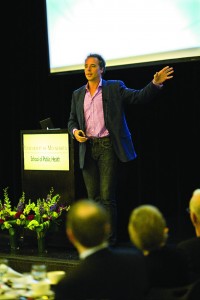My great grandmother lived to be 103. She didn’t make a decision to live that long – she simply lived. But the life she lived seemed very foreign to me at the time. She never learned to drive, walking most places instead. She had a home that was on two lots – one with the house and the other with a garden. Her washing machine was the kind you hand cranked, not the kind you plugged in.
It’s only now that I can appreciate her lifestyle, now that I myself understand more about what it means to live healthy. For most Americans, living healthy means a gym membership and shopping at the farmer’s market. While this can be part of a healthy life, it’s really so much more than that. As I’ve come to learn, a healthy life is based on personal rituals and the framework of community and family. It is life at its most simple elements: eat, laugh, love and move.
That’s perhaps what drew me to read The Blue Zones over a year ago. It’s certainly what excited me about the Get Connected to a Healthy Community initiative by Cox Hospital. When I attended the first meeting in February I was enthralled by their plan to bring the lessons of the Blue Zones to Springfield in an effort to make our community a better place to live and work.
I was even more excited to learn that Blue Zones author Dan Buettner would be in Springfield for a full day of activities. Cox had the ball rolling but I hoped that by bringing Buettner in person it would make the Power 9 principles come alive. I hoped he would inspire business and community leaders to see all that could be achieved by giving people a nudge to make better choices instead of making it harder to live a healthy life.
The Power 9 gives a great outline of what we can do as individuals. My two favorites are move naturally all day long (not just at the gym for 30 minutes) and eat a plant based diet (most common food in the diet of those in the Blue Zones? Beans). But how does one translate that into changing a community? Business needs to understand the bottom line from a dollars perspective. Cities have budgets to follow, made tighter during the economic issues of the last few years. What can be done at a community and a business level that won’t be scoffed at because of expense or time?
- Restaurants can stop calling the healthy options “healthy”. Instant turn off from a marketing perspective. Call it crunchy or spicy instead and watch sales rise up to 15%.
- Stop food waste by making the bread basket optional instead of automatic. Make people ask for the extra calories instead of tempting with them.
- Instead of mowing tons of green space, create community gardens in parks. Saves money on fuel, brings people together and provides fresh produce for those who invest their time.
- Make school classrooms and hallways food and beverage free zones. Food consumed in those places is usually junk food (like those fund raising candy bars).
I had a conversation the next day with the CEO of the company that owns the building my studio is in. They are a very wellness minded company, doing wellness programs as part of the benefits packages they design for other businesses. He said to me wellness had been a part of their mission but something about the presentation today made the light bulb go off about what it’s really going to take to transform the health of our city. I smiled and said to myself, Mission Accomplished. The collective consciousness of our community leaders has been raised. Now it’s up to the community to ask for and hold them accountable to the changes we desire.
What about your community? Has the Power 9 made it there? What is your city doing to nudge its citizens to good health?



